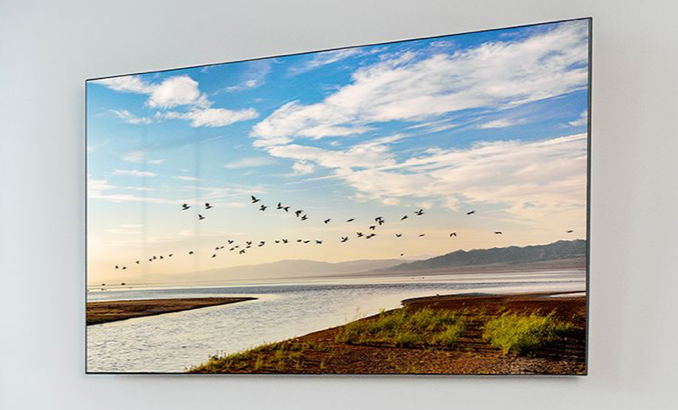Corning Unveils Astra Glass for 8K Monitors
by Anton Shilov on May 15, 2019 4:00 PM EST
Corning has introduced its new glass substrate that was developed specially for mid-to-large-size displays featuring a high pixel density. Corning’s Astra Glass takes into account not only high resolutions, but also process technologies used to make displays featuring high refresh rates, deep colors, and other attributes of next-generation desktop and mobile monitors.
Display cover glasses serve numerous purposes. Apart from protecting the screens themselves, their surfaces also affect their reflectivity, brightness, and accuracy of their color reproduction (as to some degree even work as color filters). Since all materials have a different crystal lattice, their physical properties (transparency, reflectivity, etc.) vary greatly. Considering the fact that screen technologies evolve, so should their cover glasses.
Corning believes that next generations of mid-to-large-size monitors that feature resolutions like 8K (7680×4320) will require a thermally and dimensionally stable glass that can enable desired characteristics and ensure good yields. This is where Corning’s Astra Glass comes into play. It is compatible with a variety of high-performance LCD panels, including amorphous silicon (a-Si) and IGZO oxide.
“After years of close collaboration with customers, we’ve learned what they need in an oxide display glass to bring 8K resolution to larger devices and sets – low total pitch variation, low total thickness variation, and low sag,” said Han Yim, business director, High-Performance Displays, Corning Glass Technologies. “Astra Glass meets the precise, high-temperature requirements of oxide processing.”
Corning expects its Astra Glass to be used for tablets, laptops, desktop displays, TVs, and other applications with an 8K resolution screens. The company will demonstrate prototypes of devices using its Astra Glass at the Society for Information Display’s (SID) Display Week in San Jose, California, this week.
Related Reading:
- Corning Unveils Gorilla Glass DX and Gorilla Glass DX+ for Wearables
- Corning Announces Gorilla Glass 6 for Smartphones, Doubles Durability
- Sharp Demonstrates 31.5-Inch 8K 120Hz HDR Monitor
- New 8K OLED Displays for Tablets and Laptops: 8.3 and 13.3 Inches
- Philips Demos 328P8K: 8K UHD LCD with Webcam, Docking, Coming in 2018
Source: Corning










27 Comments
View All Comments
HStewart - Wednesday, May 15, 2019 - link
Any idea on cost, these sound expensive more than $10,000 Samsung 8K TV I saw last Sunday at BestBuy.shabby - Wednesday, May 15, 2019 - link
Does this glass support 16k? Lolbcronce - Thursday, May 16, 2019 - link
I think it was AMD that said 16k per eye, think VR, is what they consider "the" limit of human vision.The real problem is that human vision is not based on quanta. It's more analog, where the center of vision is incredibly sensitive, and we can pick up artifacts by the quantization of images.
I'm thinking eye tracking will allow for dynamic resolution. That way the entire screen doesn't have to be rendered at max resolution, just the parts in the center of vision.
SteveX107 - Friday, May 17, 2019 - link
Some VR headsets already have eye tracking. However, I think the most difficult problem is projecting a processor to handle that resolutionLord of the Bored - Saturday, May 18, 2019 - link
The biggest problem is the display. Dense displays are hard to make, and thus expensive.There's current effort to cleanly embed a "microdisplay" that provides high resolution in the center of the viewing area. And efforts to make it mobile via mirrors and prisms, so that it can exist where eye-tracking says your eye is pointed.
Santoval - Monday, May 20, 2019 - link
Well, if the pixels are too small to discern even via VR the "non real life" look would be due to compression artifacts and color banding, not due to resolution. Compression artifacts and banding are much more pronounced in quite dark scenes, where a greater problem than color banding is basically "brightness banding". Limiting compression or using a more efficient codec can partially or fully resolve the issue of the artifacts. Employing 12-bit per color sources and monitors would in turn get rid of the color/brightness banding. At the very least true 10-bit monitors and sources need to be used as a bare minimum. Doing both means much larger file sizes and more expensive devices, but that's the trade-off of life like VR.imaheadcase - Wednesday, May 15, 2019 - link
"Corning expects its Astra Glass to be used for tablets, laptops, "As if people will even use 8k on those devices. lol
FunBunny2 - Wednesday, May 15, 2019 - link
"Nobody will ever need more than 640K"-- William Gates
coburn_c - Wednesday, May 15, 2019 - link
He must be the one keeping all the 4k phones at bay.imaheadcase - Thursday, May 16, 2019 - link
Nah, what keeps them at bay is people like to have a phone battery that lasts vs one that needs to be charged every 8 hours. lol